Executive Functions and Their Differential Contribution to Sustained Attention in 5- to 8-Year-Old Children
- Sarah Loher
- Claudia Roebers
Abstract
Everyday routine in general and school settings in particular make high demands on children’s abilities to sustain
their focus of attention over longer time periods. School tasks thus require the child to accomplish the task on an
appropriate level of performance while maintaining the focus of attention even under repetitious or distracting
conditions. However, sustained attention (SA) may be a more heterogeneous construct than commonly assumed
as it requires the individual not only to sustain attentional capacities but also to store and maintain the task rule
(working memory), to inhibit inappropriate responses (inhibition), and to switch according to requirements
(switching). It might thus involve processes counted among executive functions (EF). In the present study,
performance in EF tasks (covering the core components inhibition, switching, and working memory) and in a SA
task was assessed in 118 children, aged between 5;0 and 8;11 years. Similar age-dependent performance
trajectories were found in EF components and SA, indicating ongoing performance improvements between 5
until at least 8 years of age in SA and in EF. Interrelations between single EF components and SA showed to be
small to moderate. Finally, different patterns of SA performance predictions were found in age-homogeneous
subgroups with inhibition being crucial for SA performance in the youngest and switching in the oldest age
group. Taken as a whole, even though similarities in assumed developmental trajectories and substantial
interrelations point to common underlying processes in EF and SA, age-dependent patterns of explained variance
indicate clear discriminability.
- Full Text:
 PDF
PDF
- DOI:10.5539/jedp.v3n1p51
Journal Metrics
(The data was calculated based on Google Scholar Citations)
1. Google-based Impact Factor (2021): 1.11
2. h-index (December 2021): 29
3. i10-index (December 2021): 87
4. h5-index (December 2021): N/A
5. h5-median (December 2021): N/A
Index
- Academic Journals Database
- CNKI Scholar
- Copyright Clearance Center
- CrossRef
- Elektronische Zeitschriftenbibliothek (EZB)
- EuroPub Database
- Excellence in Research for Australia (ERA)
- Harvard Library
- Jisc Library Hub Discover
- JournalSeek
- JournalTOCs
- LIVIVO (ZB MED)
- LOCKSS
- MIAR
- Open Access Journals Search Engine(OAJSE)
- PKP Open Archives Harvester
- Publons
- ROAD
- Scilit
- SHERPA/RoMEO
- Standard Periodical Directory
- Stanford Libraries
- Technische Informationsbibliothek (TIB)
- UCR Library
- UoB Library
- WorldCat
- Zeitschriften Daten Bank (ZDB)
Contact
- Carol WongEditorial Assistant
- jedp@ccsenet.org
